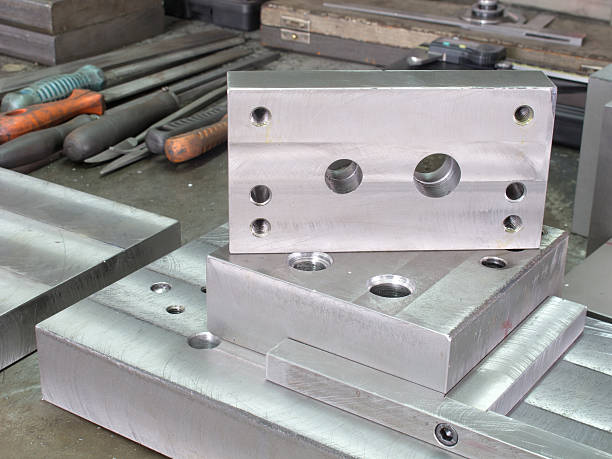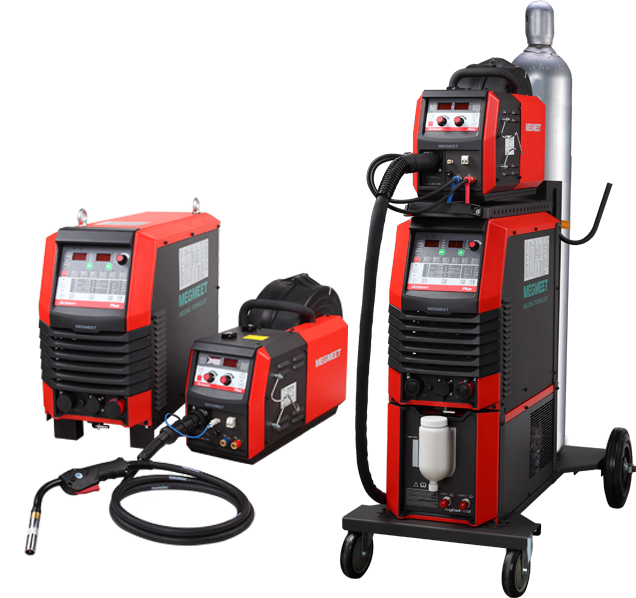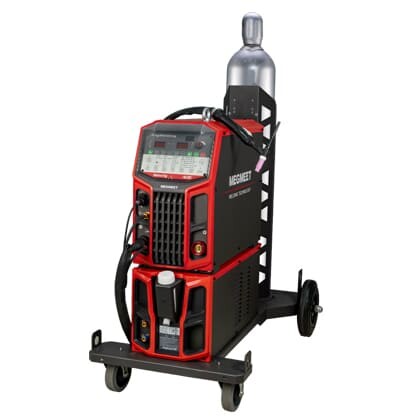Welding aluminum presents unique challenges due to its distinct metallurgical properties, such as high thermal conductivity and the formation of a tenacious oxide layer. When joining aluminum, two primary processes stand out: MIG (Gas Metal Arc Welding)and TIG (Gas Tungsten Arc Welding). While both are highly effective, understanding their nuances, advantages, and limitations is crucial for selecting the optimal process for a given application.

I. An Introduction to Aluminum Welding:
Aluminum's characteristics demand specific considerations when welding. Its high thermal conductivity means heat dissipates quickly, requiring higher heat input or preheating to achieve proper fusion. Furthermore, aluminum forms a protective, yet problematic, oxide layer that melts at a much higher temperature (approximately 3,700°F or 2,037°C) than the base metal (approximately 1,220°F or 660°C). This oxide layer must be removed or disrupted during welding to prevent inclusions and ensure a sound weld.
II. MIG Welding Aluminum Process, Challenges and Solution
MIG welding, a wire-fed process, combines the heat source and filler material into a single operation. For aluminum, specialized equipment and techniques are often employed to overcome inherent challenges.

A. Process Overview:
In MIG welding, a continuously fed wire electrode melts and forms the weld bead, while an electric arc is established between the wire and the workpiece. Shielding gas protects the molten puddle from atmospheric contamination.
B. Unique Challenges and Solutions for Aluminum MIG:
1) Soft Wire: Aluminum wire is considerably softer and more prone to kinking than steel wire. This necessitates:
Spool Guns: These compact wire feeders attach directly to the welding gun, minimizing the distance the soft wire must travel and reducing feeding issues.
Specialized Liners and Leads: Low-friction liners and thicker leads can improve wire feeding in conventional MIG setups, allowing for larger wire spools.
2) Heat Management: Aluminum's high thermal conductivity means it heats up rapidly, especially on thinner sections. Advanced MIG machines may offer:
Remote Controls: Allowing the operator to adjust amperage on the fly as the material heats up, providing greater control over the weld pool.
Pulsed MIG: A variant of MIG welding where the current rapidly alternates between a high peak and a low background, offering superior heat control, reduced spatter, and better penetration on thinner materials. While not always necessary, it's a valuable tool for challenging applications.
3) Shielding Gas: Unlike steel, which typically uses argon/CO2 mixtures, MIG welding aluminum exclusively requires 100% Argon shielding gas. Argon effectively displaces oxygen, preventing oxide formation and ensuring a stable arc.
4) Parameter Sensitivity: Aluminum MIG settings are highly sensitive and require fine-tuning. Even minor adjustments in voltage can significantly impact arc length and weld penetration. Operators often need to adjust settings based on specific wire, material thickness, and joint geometry to achieve a smooth, consistent "spray" transfer rather than the "frying bacon" sound associated with short-circuit steel MIG.
C. Technique and Appearance:
Aluminum MIG welding typically employs a "push" angle with a slightly longer stick-out than steel. The key is to maintain a steady travel speed, allowing the molten puddle to form and fill the joint. While a smooth bead is common, a "stitched" or "stack of dimes" appearance can be achieved with a slight forward and backward manipulation, but care must be taken to remain within the molten puddle to avoid defects. Crater filling is often necessary at the end of a weld to prevent crater cracks.
III. TIG Welding Aluminum Process, Challenges and Solution
TIG welding offers unparalleled control and precision, making it a preferred choice for high-quality aluminum welds.

A. Process Overview:
TIG welding utilizes a non-consumable tungsten electrode to create an arc, while filler metal is added manually by the operator. Like MIG, an inert shielding gas (typically 100% Argon) protects the weld area.
B. Key Features for Aluminum TIG:
1) Decoupled Heat and Filler Addition: This is the defining characteristic of TIG. The operator controls the heat input via a foot pedal (or fingertip control) and adds filler metal independently, providing immense flexibility for varying material thicknesses, joint geometries, and heat dissipation rates.
2) Alternating Current (AC): AC current is essential for TIG welding aluminum. The alternating polarity serves two crucial functions:
Cleaning Action (DCEP half-cycle): The reverse polarity (electrode positive) effectively breaks up and removes the tenacious aluminum oxide layer, exposing the clean base metal for welding.
Penetration (DCEN half-cycle): The straight polarity (electrode negative) provides deep penetration and efficient heat transfer to the workpiece.
3) Shielding Gas: Similar to MIG, TIG welding aluminum requires 100% Argon shielding gas. This simplifies gas management for shops welding multiple materials, as argon is a common shielding gas for many metals.
4) Precision and Control: TIG welding offers exceptional precision, allowing for very small, controlled tack welds and intricate bead placement. This is particularly advantageous for cosmetic welds or joints with tight tolerances.
C. Technique and Appearance:
TIG welding aluminum generally involves a slower travel speed than MIG. The operator maintains a steady arc length, advances the puddle, and dabs in filler metal as needed. The resulting weld bead is typically very clean, with a distinct "stack of dimes" appearance that is highly regarded for its aesthetic quality.
IV. MIG vs. TIG Welding Aluminum: A Detailed Comparison
| Feature | MIG Welding Aluminum | TIG Welding Aluminum |
| Speed/Productivity | Generally faster; high deposition rates, good for long, repetitive welds. | Slower; manual filler wire addition and precise control lead to slower travel speeds. |
| Ease of Setup | Can be more involved due to soft wire and sensitive settings (though synergic systems simplify this). | Simpler gas setup (100% Argon works for many metals). Requires an AC machine. |
| Control | Less precise control over heat and filler addition (especially without pulsed MIG). | Highly precise control over heat (foot pedal) and filler addition. |
| Appearance | Can produce good results, but often requires more post-weld cleanup; can have less aesthetic appeal than TIG. | Excellent, clean, "stack of dimes" appearance; minimal spatter or post-weld cleanup. |
| Portability | Spool guns can be bulky. Requires a separate wire feeder. | More portable in some cases, as no wire feeder is needed. Torch and filler are the main components. |
| Material Thickness | Good for both thick and thin (with pulsed MIG). | Excellent for thin materials due to precise heat control. Also good for thick. |
| Skill Level | Easier to learn the basics, especially with synergic machines. | Higher skill ceiling; requires more practice for fine motor control and coordination. |
| Equipment Cost | Generally, lower initial equipment cost for basic setups. | Typically higher initial equipment cost due to AC capability and advanced features. |
| Switchover Time | Requires changes in wire, gas, and potentially liners when switching materials. | Minimal switchover (change torch consumables/settings) when changing materials if gas is argon. |
| Joint Access | A gun can be bulky, making access to tight spaces challenging. | Torch is generally smaller, allowing for better access in confined areas. |
V. When to Choose MIG or TIG Welding Aluminum?
The choice between MIG and TIG for aluminum welding ultimately depends on the specific application, desired quality, production volume, and operator skill.
1) Choose MIG Welding Aluminum When:
Speed and Productivity are Primary Concerns: For long, repetitive welds on larger projects, MIG's higher deposition rate can significantly increase efficiency.
Cost-Effectiveness is Important: For production environments where high volumes of similar welds are required, MIG often offers a lower cost per linear foot of weld.
Operator Experience is Limited (with Synergic Systems): Synergic MIG machines make it easier for less experienced welders to achieve acceptable results on aluminum.
Welding Thicker Sections: While TIG can weld thick materials, MIG can be faster and more efficient for heavier-gauge aluminum.
Outdoor or Field Work: MIG's relative simplicity and ability to handle less-than-perfect conditions can be advantageous in outdoor or field environments.
2) Choose TIG Welding Aluminum When:
Highest Quality and Aesthetics are Paramount: For critical applications where weld integrity and visual appeal are crucial, TIG delivers superior results.
Precise Control is Required: When welding thin materials, intricate designs, or joints with tight tolerances, TIG's granular control over heat and filler is invaluable.
Repair Work and Custom Fabrication: TIG's flexibility to adapt to varying joint configurations and material thicknesses on the fly makes it ideal for repair jobs and one-off custom projects.
Welding Very Thin Materials: TIG's ability to precisely control heat input minimizes distortion and burn-through on extremely thin aluminum.
Access to Tight Spaces: The smaller TIG torch allows for better maneuverability in confined or intricate areas.
Multimaterial Welding: If you frequently switch between welding different metals (e.g., stainless steel, mild steel), TIG's consistent argon shielding gas and minimal changeover time can be a significant advantage.
VI. FAQs about MIG or TIG welding aluminum
Q1. What's the main difference between MIG and TIG welding aluminum?
MIG (Gas Metal Arc Welding) is generally faster and easier to learn for aluminum. It uses a continuously fed wire electrode and a shielding gas. TIG (Gas Tungsten Arc Welding) offers more precise control, cleaner welds, and better aesthetics, but it's slower and requires more skill. TIG uses a non-consumable tungsten electrode and a separate filler rod.
Q2. What shielding gas should I use for aluminum welding?
For both MIG and TIG welding aluminum, 100% argon is the most common and recommended shielding gas. Argon provides excellent arc stability and good penetration. Mixtures with helium can be used for thicker aluminum to increase heat input, but 100% argon is generally sufficient for most applications.
Q3. Why is it important to clean aluminum before welding?
Aluminum quickly forms an oxide layer when exposed to air, which has a much higher melting point than aluminum itself. This oxide layer can cause poor fusion, porosity, and an erratic arc if not removed. Thoroughly cleaning the joint with a stainless steel brush and a degreaser (like acetone) is crucial to achieve strong, clean welds.
Q4. Why do I need AC current for TIG welding aluminum?
Alternating Current (AC) is essential for TIG welding aluminum because it provides a "cleaning action" that helps break up and remove the stubborn aluminum oxide layer. The positive half of the AC cycle effectively blasts away the oxide, while the negative half provides the penetration. Direct Current (DC) doesn't offer this cleaning action and would lead to poor quality welds on aluminum..
Q5. What type of filler wire/rod should I use for aluminum?
The choice of filler metal depends on the aluminum alloy you're welding. Common filler alloys include 4043 and 5356. 4043 is suitable for a wide range of general-purpose aluminum alloys, while 5356 offers higher strength and better ductility, making it ideal for marine applications or when color matching after anodizing is important. Always refer to a filler metal selection chart for the best match.
Conclusion
In conclusion, both MIG and TIG are indispensable tools for welding aluminum. While MIG offers speed and ease of use (especially with synergic and pulsed capabilities), TIG provides unparalleled precision and aesthetic quality. A comprehensive understanding of each process's strengths and weaknesses empowers welders to make informed decisions, ensuring optimal results for any aluminum welding challenge.
Ready to take your aluminum welding projects to the next level? Explore Megmeet's range of aluminum welding machines for sale and discover why professionals trust their equipment for even the most demanding applications.
Related articles:
1. Pulsed MIG Welding Aluminum and Stainless Steel
2. Advantages of Utilizing Pulsed MIG Welding for Aluminum
3. MIG/MAG Pulse Welding – Why do we use it?
4. Welding Techniques Explained: MIG, TIG, Arc, and More
5. Guide to Pulsed MIG Welding in Manufacturing






